Analyzing Organizational Behavior: A Case Study of BBC's Culture
VerifiedAdded on 2020/06/06
|14
|4106
|52
Report
AI Summary
This report examines the organizational behavior within the BBC, focusing on key aspects such as culture, power dynamics, and their impact on employee behavior. It applies Handy's cultural model to analyze the BBC's organizational structure and highlights the significance of culture in influencing employee perception and satisfaction. The report delves into motivational theories, including content and process theories, and their importance in enhancing employee performance. It also explores various types of teams and the stages of team development, along with the application of the path-goal theory to improve team performance. Furthermore, the report identifies barriers to effective performance within the BBC and suggests strategies to improve employee motivation, such as providing incentives, adopting a flat organizational structure, and fostering open communication channels.
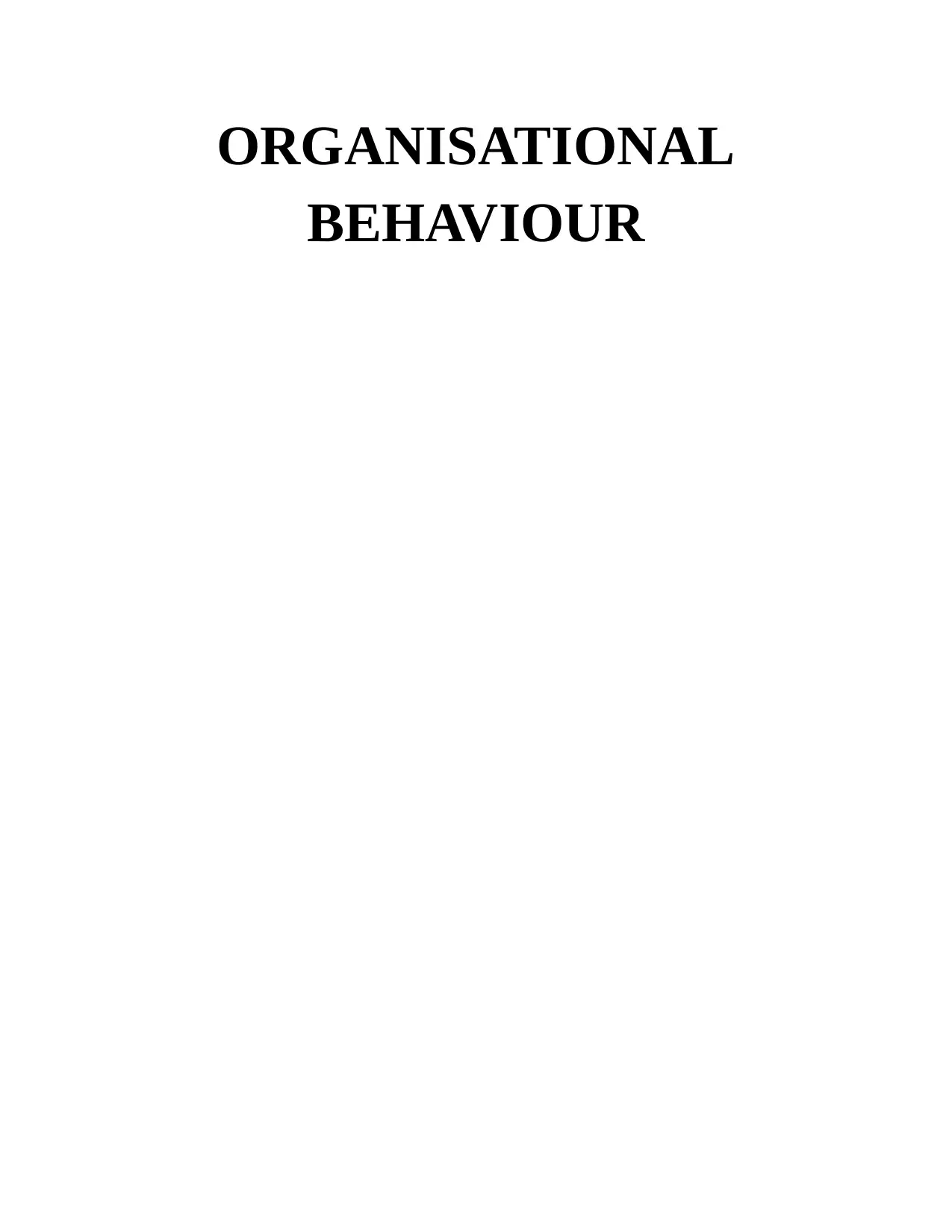
ORGANISATIONAL
BEHAVIOUR
BEHAVIOUR
Paraphrase This Document
Need a fresh take? Get an instant paraphrase of this document with our AI Paraphraser
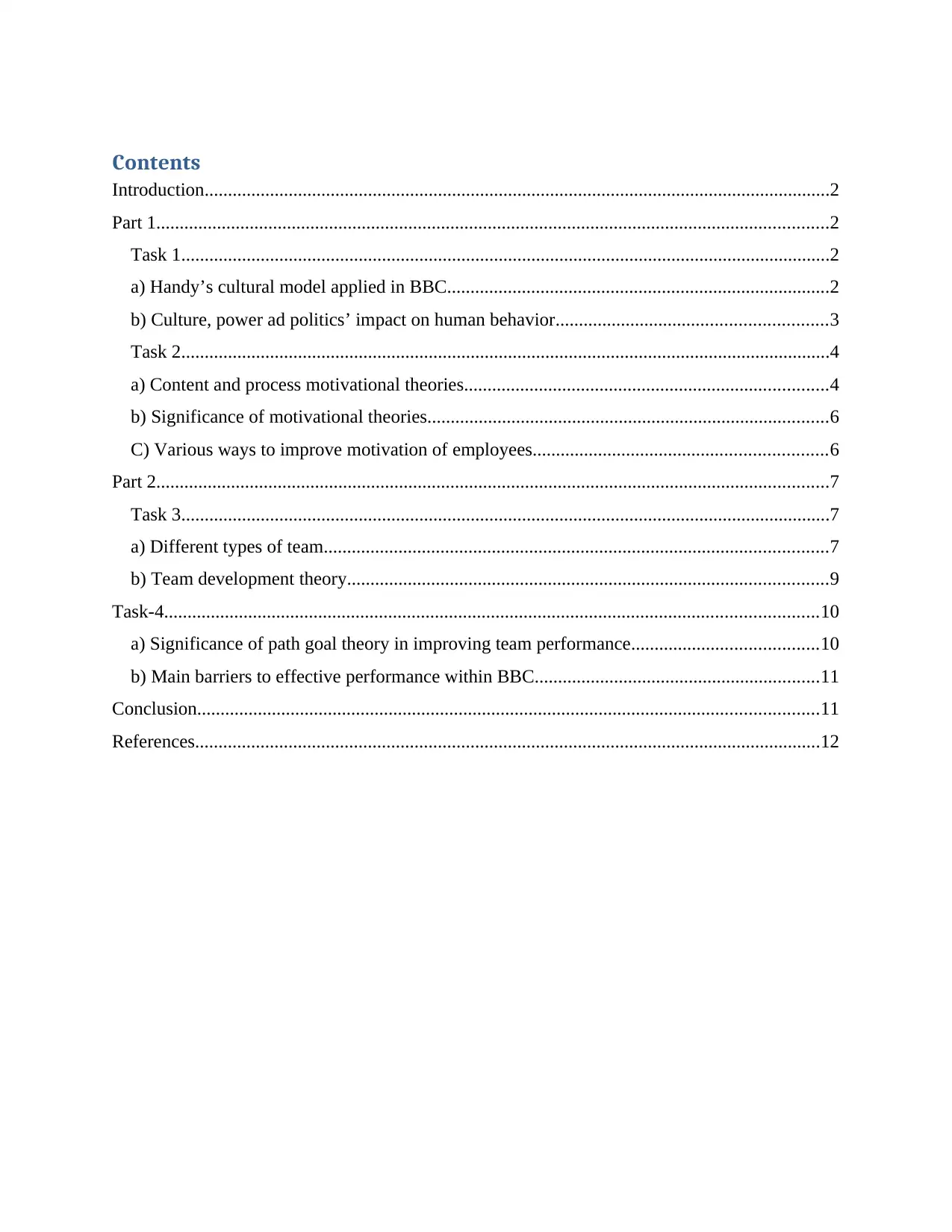
Contents
Introduction......................................................................................................................................2
Part 1................................................................................................................................................2
Task 1...........................................................................................................................................2
a) Handy’s cultural model applied in BBC..................................................................................2
b) Culture, power ad politics’ impact on human behavior..........................................................3
Task 2...........................................................................................................................................4
a) Content and process motivational theories..............................................................................4
b) Significance of motivational theories......................................................................................6
C) Various ways to improve motivation of employees...............................................................6
Part 2................................................................................................................................................7
Task 3...........................................................................................................................................7
a) Different types of team............................................................................................................7
b) Team development theory.......................................................................................................9
Task-4............................................................................................................................................10
a) Significance of path goal theory in improving team performance........................................10
b) Main barriers to effective performance within BBC.............................................................11
Conclusion.....................................................................................................................................11
References......................................................................................................................................12
Introduction......................................................................................................................................2
Part 1................................................................................................................................................2
Task 1...........................................................................................................................................2
a) Handy’s cultural model applied in BBC..................................................................................2
b) Culture, power ad politics’ impact on human behavior..........................................................3
Task 2...........................................................................................................................................4
a) Content and process motivational theories..............................................................................4
b) Significance of motivational theories......................................................................................6
C) Various ways to improve motivation of employees...............................................................6
Part 2................................................................................................................................................7
Task 3...........................................................................................................................................7
a) Different types of team............................................................................................................7
b) Team development theory.......................................................................................................9
Task-4............................................................................................................................................10
a) Significance of path goal theory in improving team performance........................................10
b) Main barriers to effective performance within BBC.............................................................11
Conclusion.....................................................................................................................................11
References......................................................................................................................................12
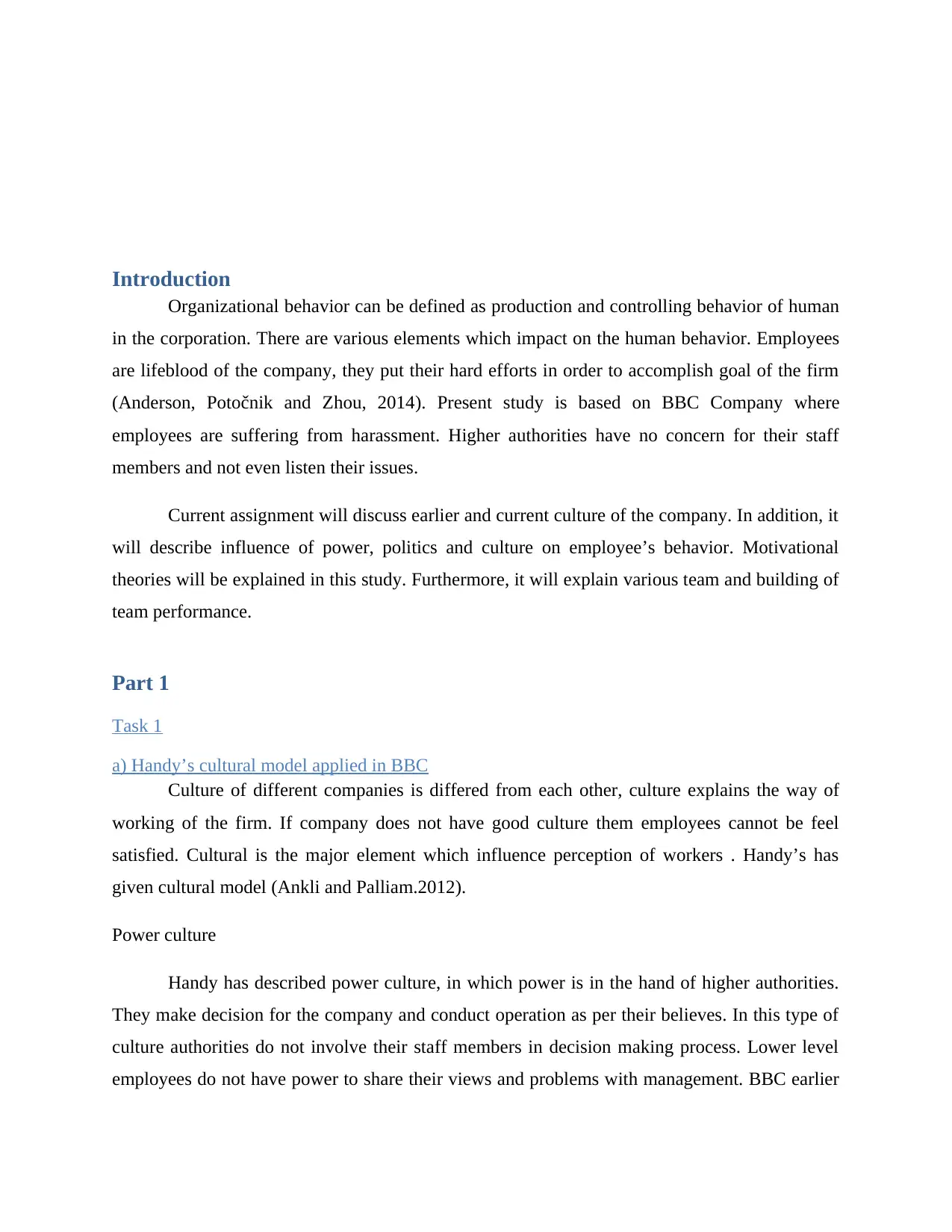
Introduction
Organizational behavior can be defined as production and controlling behavior of human
in the corporation. There are various elements which impact on the human behavior. Employees
are lifeblood of the company, they put their hard efforts in order to accomplish goal of the firm
(Anderson, Potočnik and Zhou, 2014). Present study is based on BBC Company where
employees are suffering from harassment. Higher authorities have no concern for their staff
members and not even listen their issues.
Current assignment will discuss earlier and current culture of the company. In addition, it
will describe influence of power, politics and culture on employee’s behavior. Motivational
theories will be explained in this study. Furthermore, it will explain various team and building of
team performance.
Part 1
Task 1
a) Handy’s cultural model applied in BBC
Culture of different companies is differed from each other, culture explains the way of
working of the firm. If company does not have good culture them employees cannot be feel
satisfied. Cultural is the major element which influence perception of workers . Handy’s has
given cultural model (Ankli and Palliam.2012).
Power culture
Handy has described power culture, in which power is in the hand of higher authorities.
They make decision for the company and conduct operation as per their believes. In this type of
culture authorities do not involve their staff members in decision making process. Lower level
employees do not have power to share their views and problems with management. BBC earlier
Organizational behavior can be defined as production and controlling behavior of human
in the corporation. There are various elements which impact on the human behavior. Employees
are lifeblood of the company, they put their hard efforts in order to accomplish goal of the firm
(Anderson, Potočnik and Zhou, 2014). Present study is based on BBC Company where
employees are suffering from harassment. Higher authorities have no concern for their staff
members and not even listen their issues.
Current assignment will discuss earlier and current culture of the company. In addition, it
will describe influence of power, politics and culture on employee’s behavior. Motivational
theories will be explained in this study. Furthermore, it will explain various team and building of
team performance.
Part 1
Task 1
a) Handy’s cultural model applied in BBC
Culture of different companies is differed from each other, culture explains the way of
working of the firm. If company does not have good culture them employees cannot be feel
satisfied. Cultural is the major element which influence perception of workers . Handy’s has
given cultural model (Ankli and Palliam.2012).
Power culture
Handy has described power culture, in which power is in the hand of higher authorities.
They make decision for the company and conduct operation as per their believes. In this type of
culture authorities do not involve their staff members in decision making process. Lower level
employees do not have power to share their views and problems with management. BBC earlier
⊘ This is a preview!⊘
Do you want full access?
Subscribe today to unlock all pages.

Trusted by 1+ million students worldwide
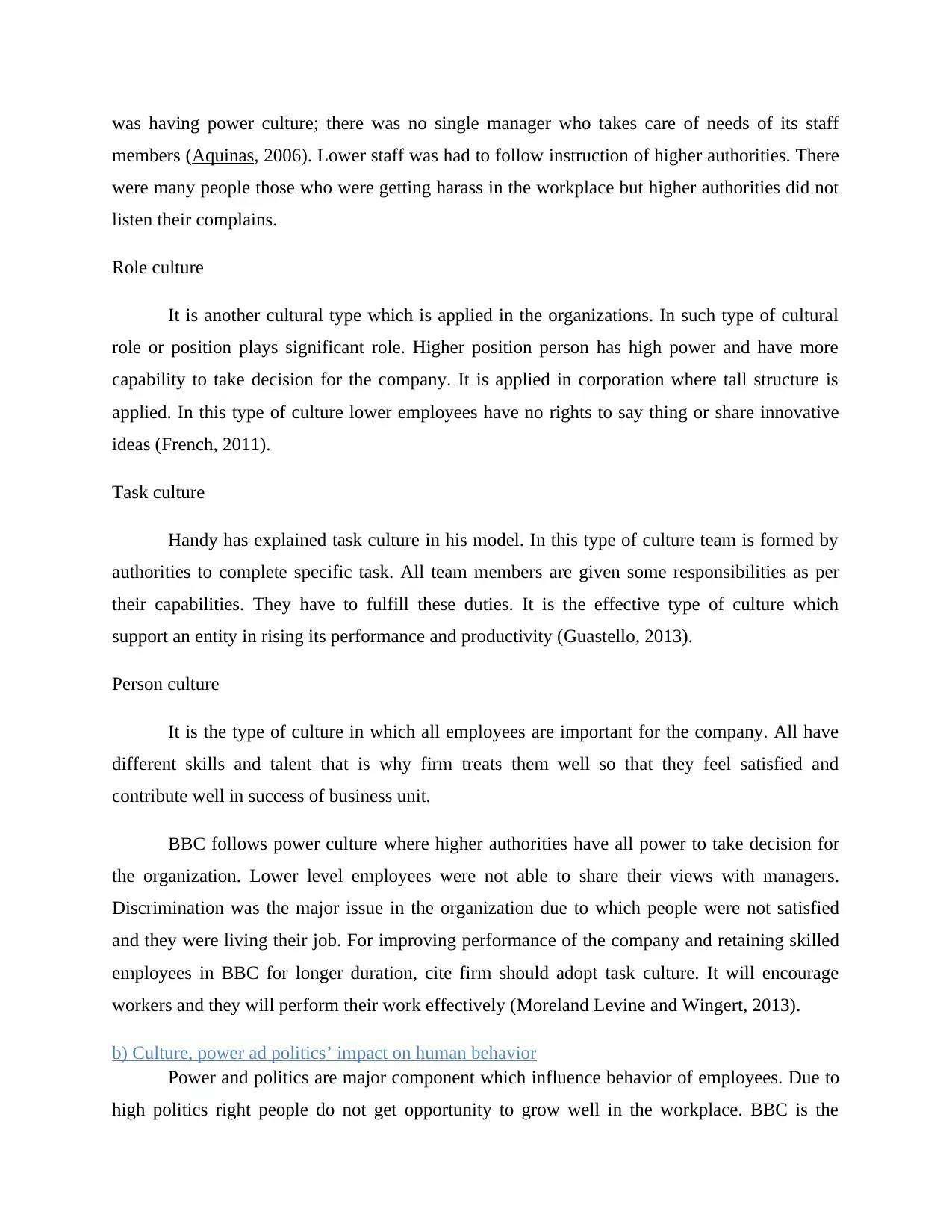
was having power culture; there was no single manager who takes care of needs of its staff
members (Aquinas, 2006). Lower staff was had to follow instruction of higher authorities. There
were many people those who were getting harass in the workplace but higher authorities did not
listen their complains.
Role culture
It is another cultural type which is applied in the organizations. In such type of cultural
role or position plays significant role. Higher position person has high power and have more
capability to take decision for the company. It is applied in corporation where tall structure is
applied. In this type of culture lower employees have no rights to say thing or share innovative
ideas (French, 2011).
Task culture
Handy has explained task culture in his model. In this type of culture team is formed by
authorities to complete specific task. All team members are given some responsibilities as per
their capabilities. They have to fulfill these duties. It is the effective type of culture which
support an entity in rising its performance and productivity (Guastello, 2013).
Person culture
It is the type of culture in which all employees are important for the company. All have
different skills and talent that is why firm treats them well so that they feel satisfied and
contribute well in success of business unit.
BBC follows power culture where higher authorities have all power to take decision for
the organization. Lower level employees were not able to share their views with managers.
Discrimination was the major issue in the organization due to which people were not satisfied
and they were living their job. For improving performance of the company and retaining skilled
employees in BBC for longer duration, cite firm should adopt task culture. It will encourage
workers and they will perform their work effectively (Moreland Levine and Wingert, 2013).
b) Culture, power ad politics’ impact on human behavior
Power and politics are major component which influence behavior of employees. Due to
high politics right people do not get opportunity to grow well in the workplace. BBC is the
members (Aquinas, 2006). Lower staff was had to follow instruction of higher authorities. There
were many people those who were getting harass in the workplace but higher authorities did not
listen their complains.
Role culture
It is another cultural type which is applied in the organizations. In such type of cultural
role or position plays significant role. Higher position person has high power and have more
capability to take decision for the company. It is applied in corporation where tall structure is
applied. In this type of culture lower employees have no rights to say thing or share innovative
ideas (French, 2011).
Task culture
Handy has explained task culture in his model. In this type of culture team is formed by
authorities to complete specific task. All team members are given some responsibilities as per
their capabilities. They have to fulfill these duties. It is the effective type of culture which
support an entity in rising its performance and productivity (Guastello, 2013).
Person culture
It is the type of culture in which all employees are important for the company. All have
different skills and talent that is why firm treats them well so that they feel satisfied and
contribute well in success of business unit.
BBC follows power culture where higher authorities have all power to take decision for
the organization. Lower level employees were not able to share their views with managers.
Discrimination was the major issue in the organization due to which people were not satisfied
and they were living their job. For improving performance of the company and retaining skilled
employees in BBC for longer duration, cite firm should adopt task culture. It will encourage
workers and they will perform their work effectively (Moreland Levine and Wingert, 2013).
b) Culture, power ad politics’ impact on human behavior
Power and politics are major component which influence behavior of employees. Due to
high politics right people do not get opportunity to grow well in the workplace. BBC is the
Paraphrase This Document
Need a fresh take? Get an instant paraphrase of this document with our AI Paraphraser
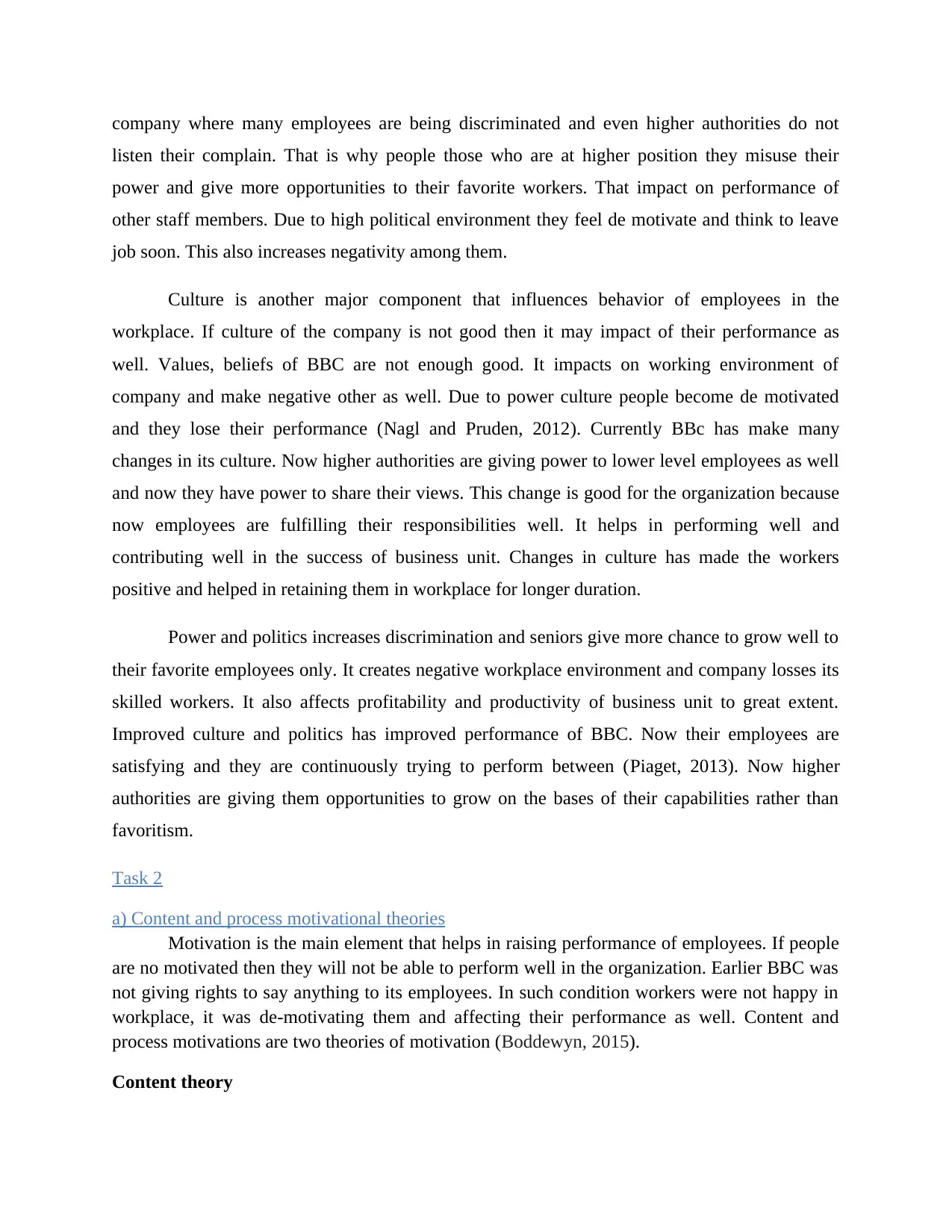
company where many employees are being discriminated and even higher authorities do not
listen their complain. That is why people those who are at higher position they misuse their
power and give more opportunities to their favorite workers. That impact on performance of
other staff members. Due to high political environment they feel de motivate and think to leave
job soon. This also increases negativity among them.
Culture is another major component that influences behavior of employees in the
workplace. If culture of the company is not good then it may impact of their performance as
well. Values, beliefs of BBC are not enough good. It impacts on working environment of
company and make negative other as well. Due to power culture people become de motivated
and they lose their performance (Nagl and Pruden, 2012). Currently BBc has make many
changes in its culture. Now higher authorities are giving power to lower level employees as well
and now they have power to share their views. This change is good for the organization because
now employees are fulfilling their responsibilities well. It helps in performing well and
contributing well in the success of business unit. Changes in culture has made the workers
positive and helped in retaining them in workplace for longer duration.
Power and politics increases discrimination and seniors give more chance to grow well to
their favorite employees only. It creates negative workplace environment and company losses its
skilled workers. It also affects profitability and productivity of business unit to great extent.
Improved culture and politics has improved performance of BBC. Now their employees are
satisfying and they are continuously trying to perform between (Piaget, 2013). Now higher
authorities are giving them opportunities to grow on the bases of their capabilities rather than
favoritism.
Task 2
a) Content and process motivational theories
Motivation is the main element that helps in raising performance of employees. If people
are no motivated then they will not be able to perform well in the organization. Earlier BBC was
not giving rights to say anything to its employees. In such condition workers were not happy in
workplace, it was de-motivating them and affecting their performance as well. Content and
process motivations are two theories of motivation (Boddewyn, 2015).
Content theory
listen their complain. That is why people those who are at higher position they misuse their
power and give more opportunities to their favorite workers. That impact on performance of
other staff members. Due to high political environment they feel de motivate and think to leave
job soon. This also increases negativity among them.
Culture is another major component that influences behavior of employees in the
workplace. If culture of the company is not good then it may impact of their performance as
well. Values, beliefs of BBC are not enough good. It impacts on working environment of
company and make negative other as well. Due to power culture people become de motivated
and they lose their performance (Nagl and Pruden, 2012). Currently BBc has make many
changes in its culture. Now higher authorities are giving power to lower level employees as well
and now they have power to share their views. This change is good for the organization because
now employees are fulfilling their responsibilities well. It helps in performing well and
contributing well in the success of business unit. Changes in culture has made the workers
positive and helped in retaining them in workplace for longer duration.
Power and politics increases discrimination and seniors give more chance to grow well to
their favorite employees only. It creates negative workplace environment and company losses its
skilled workers. It also affects profitability and productivity of business unit to great extent.
Improved culture and politics has improved performance of BBC. Now their employees are
satisfying and they are continuously trying to perform between (Piaget, 2013). Now higher
authorities are giving them opportunities to grow on the bases of their capabilities rather than
favoritism.
Task 2
a) Content and process motivational theories
Motivation is the main element that helps in raising performance of employees. If people
are no motivated then they will not be able to perform well in the organization. Earlier BBC was
not giving rights to say anything to its employees. In such condition workers were not happy in
workplace, it was de-motivating them and affecting their performance as well. Content and
process motivations are two theories of motivation (Boddewyn, 2015).
Content theory
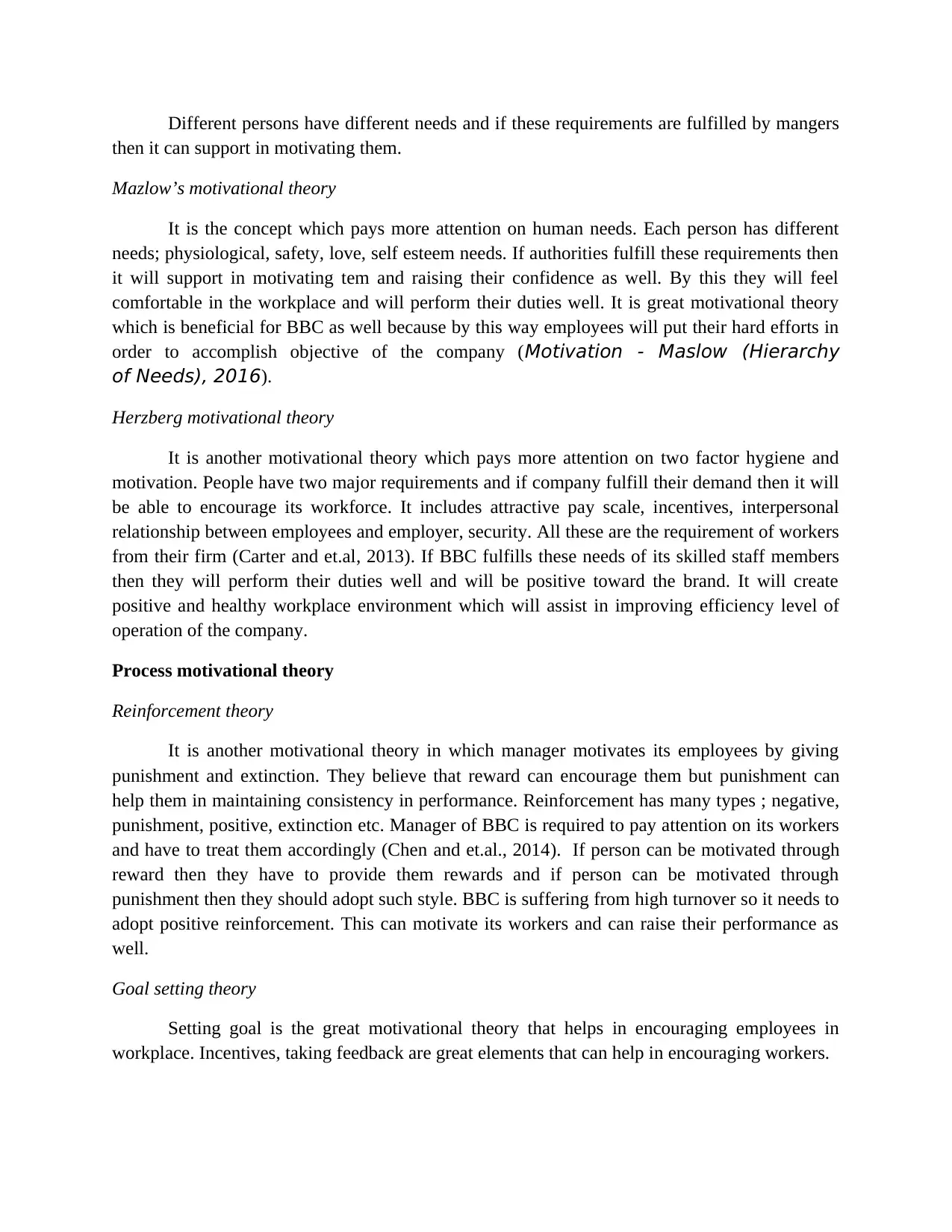
Different persons have different needs and if these requirements are fulfilled by mangers
then it can support in motivating them.
Mazlow’s motivational theory
It is the concept which pays more attention on human needs. Each person has different
needs; physiological, safety, love, self esteem needs. If authorities fulfill these requirements then
it will support in motivating tem and raising their confidence as well. By this they will feel
comfortable in the workplace and will perform their duties well. It is great motivational theory
which is beneficial for BBC as well because by this way employees will put their hard efforts in
order to accomplish objective of the company (Motivation - Maslow (Hierarchy
of Needs), 2016).
Herzberg motivational theory
It is another motivational theory which pays more attention on two factor hygiene and
motivation. People have two major requirements and if company fulfill their demand then it will
be able to encourage its workforce. It includes attractive pay scale, incentives, interpersonal
relationship between employees and employer, security. All these are the requirement of workers
from their firm (Carter and et.al, 2013). If BBC fulfills these needs of its skilled staff members
then they will perform their duties well and will be positive toward the brand. It will create
positive and healthy workplace environment which will assist in improving efficiency level of
operation of the company.
Process motivational theory
Reinforcement theory
It is another motivational theory in which manager motivates its employees by giving
punishment and extinction. They believe that reward can encourage them but punishment can
help them in maintaining consistency in performance. Reinforcement has many types ; negative,
punishment, positive, extinction etc. Manager of BBC is required to pay attention on its workers
and have to treat them accordingly (Chen and et.al., 2014). If person can be motivated through
reward then they have to provide them rewards and if person can be motivated through
punishment then they should adopt such style. BBC is suffering from high turnover so it needs to
adopt positive reinforcement. This can motivate its workers and can raise their performance as
well.
Goal setting theory
Setting goal is the great motivational theory that helps in encouraging employees in
workplace. Incentives, taking feedback are great elements that can help in encouraging workers.
then it can support in motivating them.
Mazlow’s motivational theory
It is the concept which pays more attention on human needs. Each person has different
needs; physiological, safety, love, self esteem needs. If authorities fulfill these requirements then
it will support in motivating tem and raising their confidence as well. By this they will feel
comfortable in the workplace and will perform their duties well. It is great motivational theory
which is beneficial for BBC as well because by this way employees will put their hard efforts in
order to accomplish objective of the company (Motivation - Maslow (Hierarchy
of Needs), 2016).
Herzberg motivational theory
It is another motivational theory which pays more attention on two factor hygiene and
motivation. People have two major requirements and if company fulfill their demand then it will
be able to encourage its workforce. It includes attractive pay scale, incentives, interpersonal
relationship between employees and employer, security. All these are the requirement of workers
from their firm (Carter and et.al, 2013). If BBC fulfills these needs of its skilled staff members
then they will perform their duties well and will be positive toward the brand. It will create
positive and healthy workplace environment which will assist in improving efficiency level of
operation of the company.
Process motivational theory
Reinforcement theory
It is another motivational theory in which manager motivates its employees by giving
punishment and extinction. They believe that reward can encourage them but punishment can
help them in maintaining consistency in performance. Reinforcement has many types ; negative,
punishment, positive, extinction etc. Manager of BBC is required to pay attention on its workers
and have to treat them accordingly (Chen and et.al., 2014). If person can be motivated through
reward then they have to provide them rewards and if person can be motivated through
punishment then they should adopt such style. BBC is suffering from high turnover so it needs to
adopt positive reinforcement. This can motivate its workers and can raise their performance as
well.
Goal setting theory
Setting goal is the great motivational theory that helps in encouraging employees in
workplace. Incentives, taking feedback are great elements that can help in encouraging workers.
⊘ This is a preview!⊘
Do you want full access?
Subscribe today to unlock all pages.

Trusted by 1+ million students worldwide
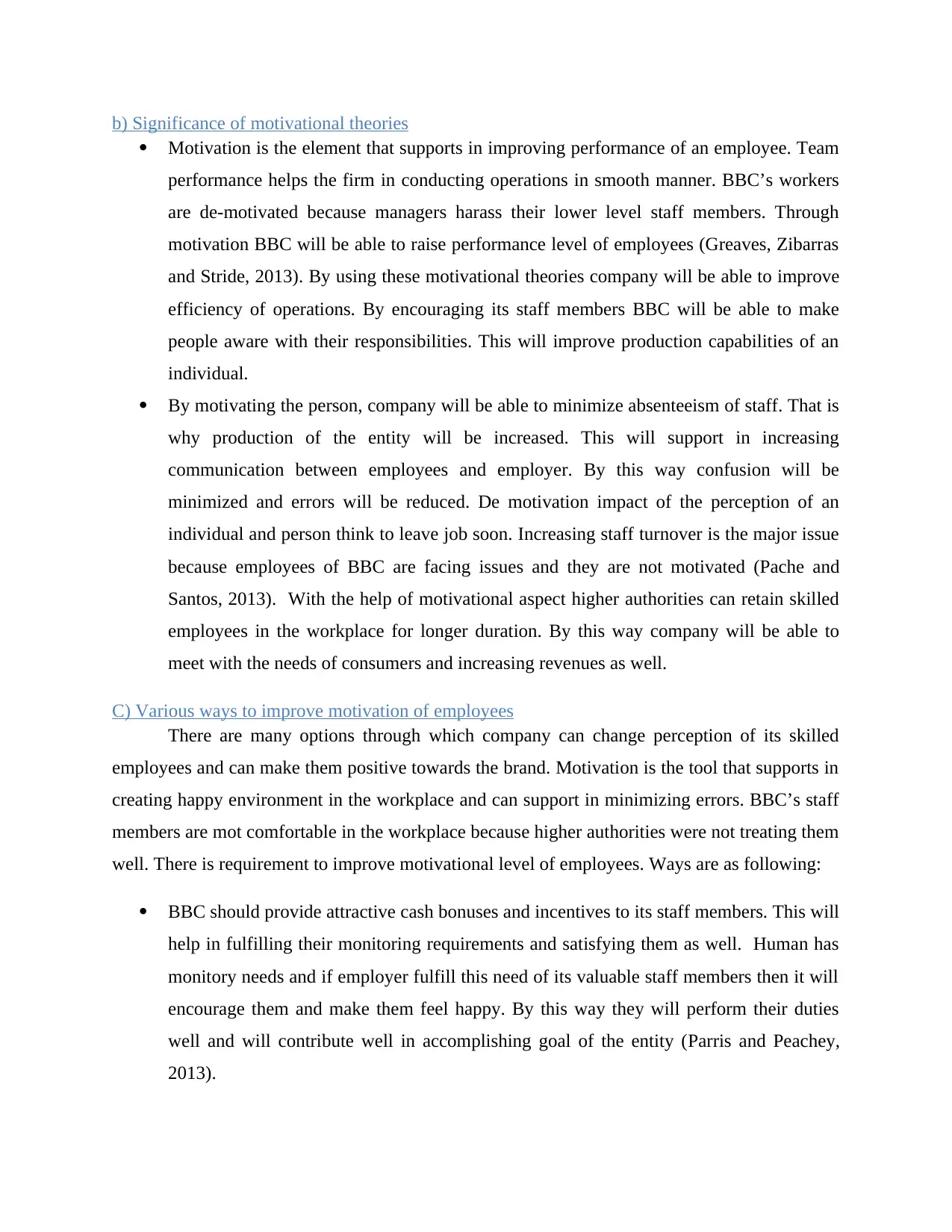
b) Significance of motivational theories
Motivation is the element that supports in improving performance of an employee. Team
performance helps the firm in conducting operations in smooth manner. BBC’s workers
are de-motivated because managers harass their lower level staff members. Through
motivation BBC will be able to raise performance level of employees (Greaves, Zibarras
and Stride, 2013). By using these motivational theories company will be able to improve
efficiency of operations. By encouraging its staff members BBC will be able to make
people aware with their responsibilities. This will improve production capabilities of an
individual.
By motivating the person, company will be able to minimize absenteeism of staff. That is
why production of the entity will be increased. This will support in increasing
communication between employees and employer. By this way confusion will be
minimized and errors will be reduced. De motivation impact of the perception of an
individual and person think to leave job soon. Increasing staff turnover is the major issue
because employees of BBC are facing issues and they are not motivated (Pache and
Santos, 2013). With the help of motivational aspect higher authorities can retain skilled
employees in the workplace for longer duration. By this way company will be able to
meet with the needs of consumers and increasing revenues as well.
C) Various ways to improve motivation of employees
There are many options through which company can change perception of its skilled
employees and can make them positive towards the brand. Motivation is the tool that supports in
creating happy environment in the workplace and can support in minimizing errors. BBC’s staff
members are mot comfortable in the workplace because higher authorities were not treating them
well. There is requirement to improve motivational level of employees. Ways are as following:
BBC should provide attractive cash bonuses and incentives to its staff members. This will
help in fulfilling their monitoring requirements and satisfying them as well. Human has
monitory needs and if employer fulfill this need of its valuable staff members then it will
encourage them and make them feel happy. By this way they will perform their duties
well and will contribute well in accomplishing goal of the entity (Parris and Peachey,
2013).
Motivation is the element that supports in improving performance of an employee. Team
performance helps the firm in conducting operations in smooth manner. BBC’s workers
are de-motivated because managers harass their lower level staff members. Through
motivation BBC will be able to raise performance level of employees (Greaves, Zibarras
and Stride, 2013). By using these motivational theories company will be able to improve
efficiency of operations. By encouraging its staff members BBC will be able to make
people aware with their responsibilities. This will improve production capabilities of an
individual.
By motivating the person, company will be able to minimize absenteeism of staff. That is
why production of the entity will be increased. This will support in increasing
communication between employees and employer. By this way confusion will be
minimized and errors will be reduced. De motivation impact of the perception of an
individual and person think to leave job soon. Increasing staff turnover is the major issue
because employees of BBC are facing issues and they are not motivated (Pache and
Santos, 2013). With the help of motivational aspect higher authorities can retain skilled
employees in the workplace for longer duration. By this way company will be able to
meet with the needs of consumers and increasing revenues as well.
C) Various ways to improve motivation of employees
There are many options through which company can change perception of its skilled
employees and can make them positive towards the brand. Motivation is the tool that supports in
creating happy environment in the workplace and can support in minimizing errors. BBC’s staff
members are mot comfortable in the workplace because higher authorities were not treating them
well. There is requirement to improve motivational level of employees. Ways are as following:
BBC should provide attractive cash bonuses and incentives to its staff members. This will
help in fulfilling their monitoring requirements and satisfying them as well. Human has
monitory needs and if employer fulfill this need of its valuable staff members then it will
encourage them and make them feel happy. By this way they will perform their duties
well and will contribute well in accomplishing goal of the entity (Parris and Peachey,
2013).
Paraphrase This Document
Need a fresh take? Get an instant paraphrase of this document with our AI Paraphraser
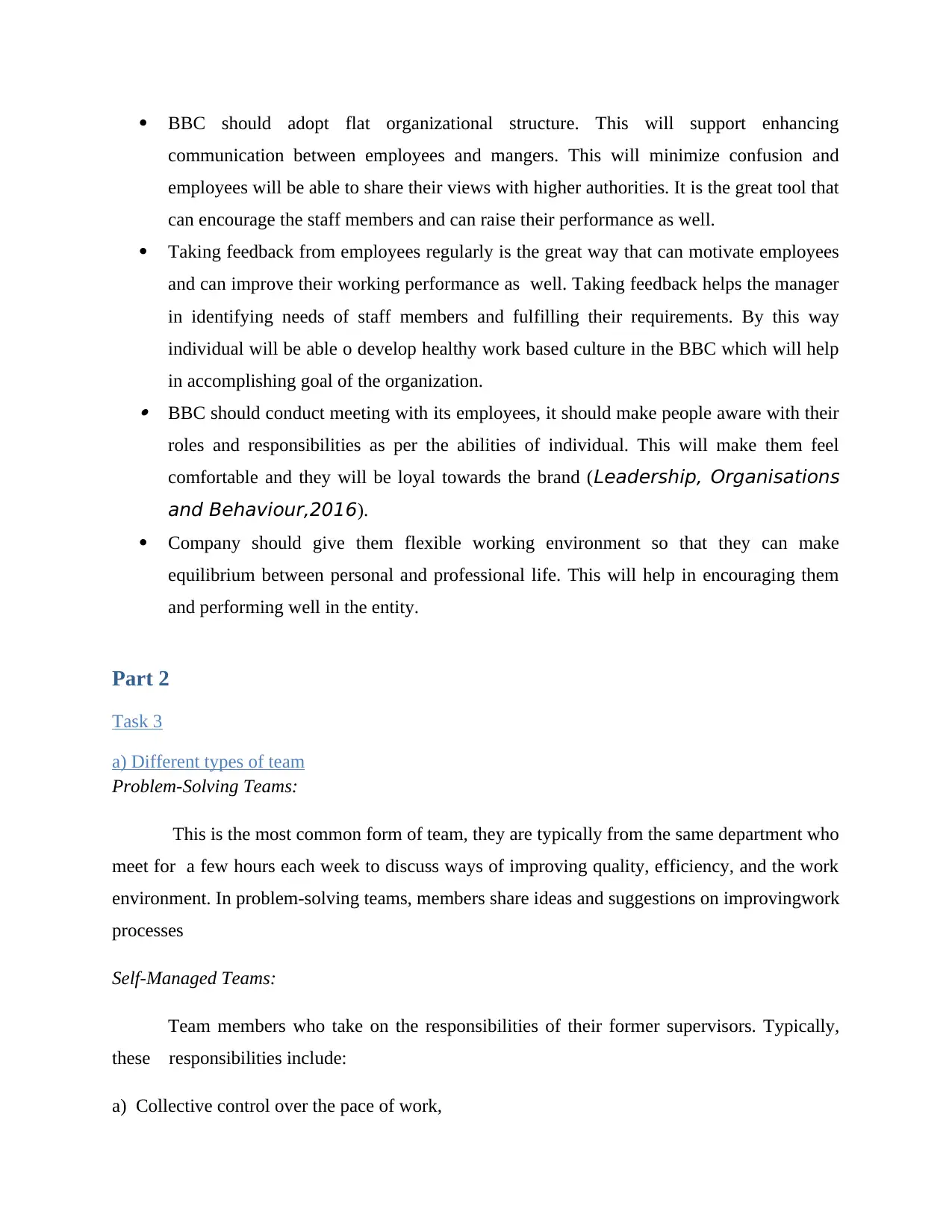
BBC should adopt flat organizational structure. This will support enhancing
communication between employees and mangers. This will minimize confusion and
employees will be able to share their views with higher authorities. It is the great tool that
can encourage the staff members and can raise their performance as well.
Taking feedback from employees regularly is the great way that can motivate employees
and can improve their working performance as well. Taking feedback helps the manager
in identifying needs of staff members and fulfilling their requirements. By this way
individual will be able o develop healthy work based culture in the BBC which will help
in accomplishing goal of the organization. BBC should conduct meeting with its employees, it should make people aware with their
roles and responsibilities as per the abilities of individual. This will make them feel
comfortable and they will be loyal towards the brand (Leadership, Organisations
and Behaviour,2016).
Company should give them flexible working environment so that they can make
equilibrium between personal and professional life. This will help in encouraging them
and performing well in the entity.
Part 2
Task 3
a) Different types of team
Problem-Solving Teams:
This is the most common form of team, they are typically from the same department who
meet for a few hours each week to discuss ways of improving quality, efficiency, and the work
environment. In problem-solving teams, members share ideas and suggestions on improvingwork
processes
Self-Managed Teams:
Team members who take on the responsibilities of their former supervisors. Typically,
these responsibilities include:
a) Collective control over the pace of work,
communication between employees and mangers. This will minimize confusion and
employees will be able to share their views with higher authorities. It is the great tool that
can encourage the staff members and can raise their performance as well.
Taking feedback from employees regularly is the great way that can motivate employees
and can improve their working performance as well. Taking feedback helps the manager
in identifying needs of staff members and fulfilling their requirements. By this way
individual will be able o develop healthy work based culture in the BBC which will help
in accomplishing goal of the organization. BBC should conduct meeting with its employees, it should make people aware with their
roles and responsibilities as per the abilities of individual. This will make them feel
comfortable and they will be loyal towards the brand (Leadership, Organisations
and Behaviour,2016).
Company should give them flexible working environment so that they can make
equilibrium between personal and professional life. This will help in encouraging them
and performing well in the entity.
Part 2
Task 3
a) Different types of team
Problem-Solving Teams:
This is the most common form of team, they are typically from the same department who
meet for a few hours each week to discuss ways of improving quality, efficiency, and the work
environment. In problem-solving teams, members share ideas and suggestions on improvingwork
processes
Self-Managed Teams:
Team members who take on the responsibilities of their former supervisors. Typically,
these responsibilities include:
a) Collective control over the pace of work,
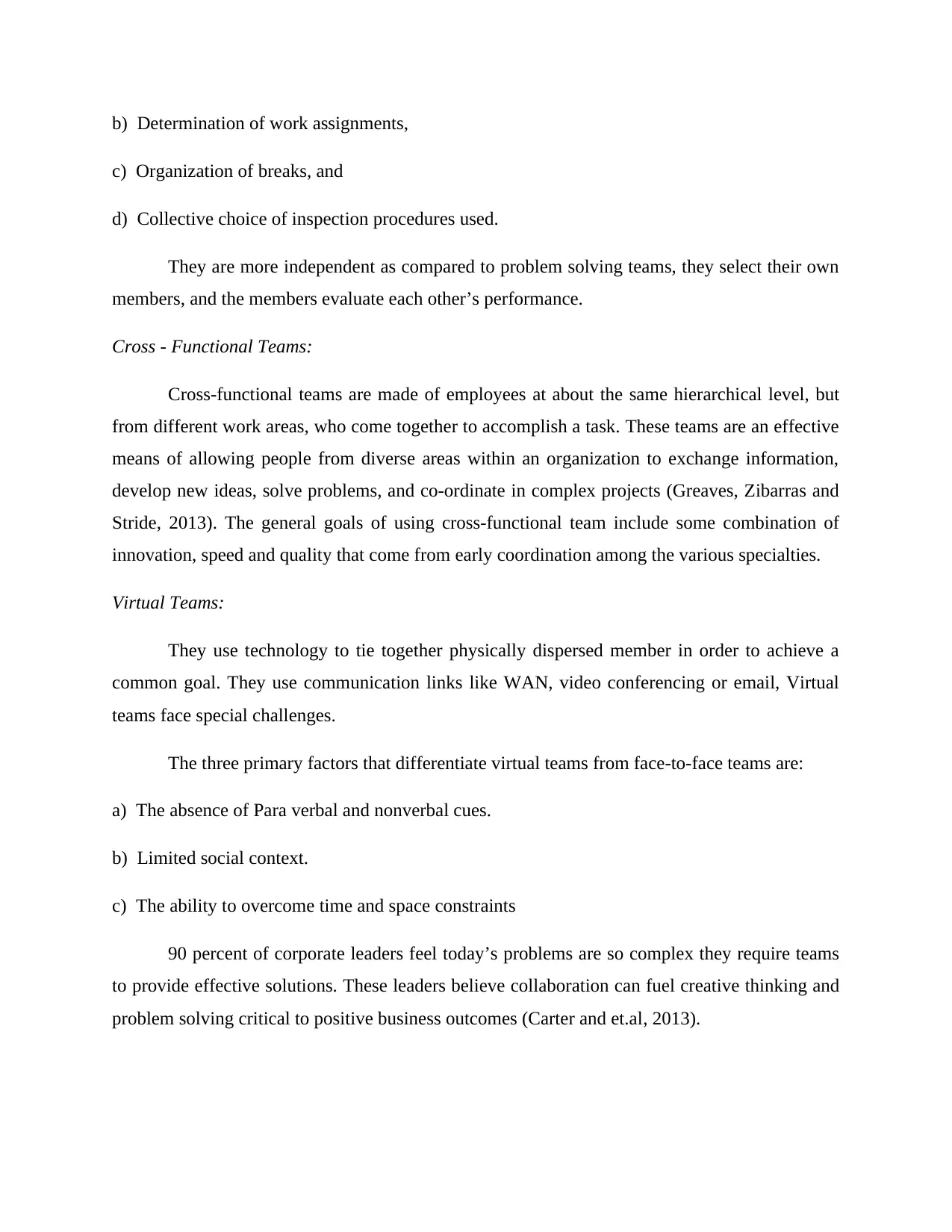
b) Determination of work assignments,
c) Organization of breaks, and
d) Collective choice of inspection procedures used.
They are more independent as compared to problem solving teams, they select their own
members, and the members evaluate each other’s performance.
Cross - Functional Teams:
Cross-functional teams are made of employees at about the same hierarchical level, but
from different work areas, who come together to accomplish a task. These teams are an effective
means of allowing people from diverse areas within an organization to exchange information,
develop new ideas, solve problems, and co-ordinate in complex projects (Greaves, Zibarras and
Stride, 2013). The general goals of using cross-functional team include some combination of
innovation, speed and quality that come from early coordination among the various specialties.
Virtual Teams:
They use technology to tie together physically dispersed member in order to achieve a
common goal. They use communication links like WAN, video conferencing or email, Virtual
teams face special challenges.
The three primary factors that differentiate virtual teams from face-to-face teams are:
a) The absence of Para verbal and nonverbal cues.
b) Limited social context.
c) The ability to overcome time and space constraints
90 percent of corporate leaders feel today’s problems are so complex they require teams
to provide effective solutions. These leaders believe collaboration can fuel creative thinking and
problem solving critical to positive business outcomes (Carter and et.al, 2013).
c) Organization of breaks, and
d) Collective choice of inspection procedures used.
They are more independent as compared to problem solving teams, they select their own
members, and the members evaluate each other’s performance.
Cross - Functional Teams:
Cross-functional teams are made of employees at about the same hierarchical level, but
from different work areas, who come together to accomplish a task. These teams are an effective
means of allowing people from diverse areas within an organization to exchange information,
develop new ideas, solve problems, and co-ordinate in complex projects (Greaves, Zibarras and
Stride, 2013). The general goals of using cross-functional team include some combination of
innovation, speed and quality that come from early coordination among the various specialties.
Virtual Teams:
They use technology to tie together physically dispersed member in order to achieve a
common goal. They use communication links like WAN, video conferencing or email, Virtual
teams face special challenges.
The three primary factors that differentiate virtual teams from face-to-face teams are:
a) The absence of Para verbal and nonverbal cues.
b) Limited social context.
c) The ability to overcome time and space constraints
90 percent of corporate leaders feel today’s problems are so complex they require teams
to provide effective solutions. These leaders believe collaboration can fuel creative thinking and
problem solving critical to positive business outcomes (Carter and et.al, 2013).
⊘ This is a preview!⊘
Do you want full access?
Subscribe today to unlock all pages.

Trusted by 1+ million students worldwide
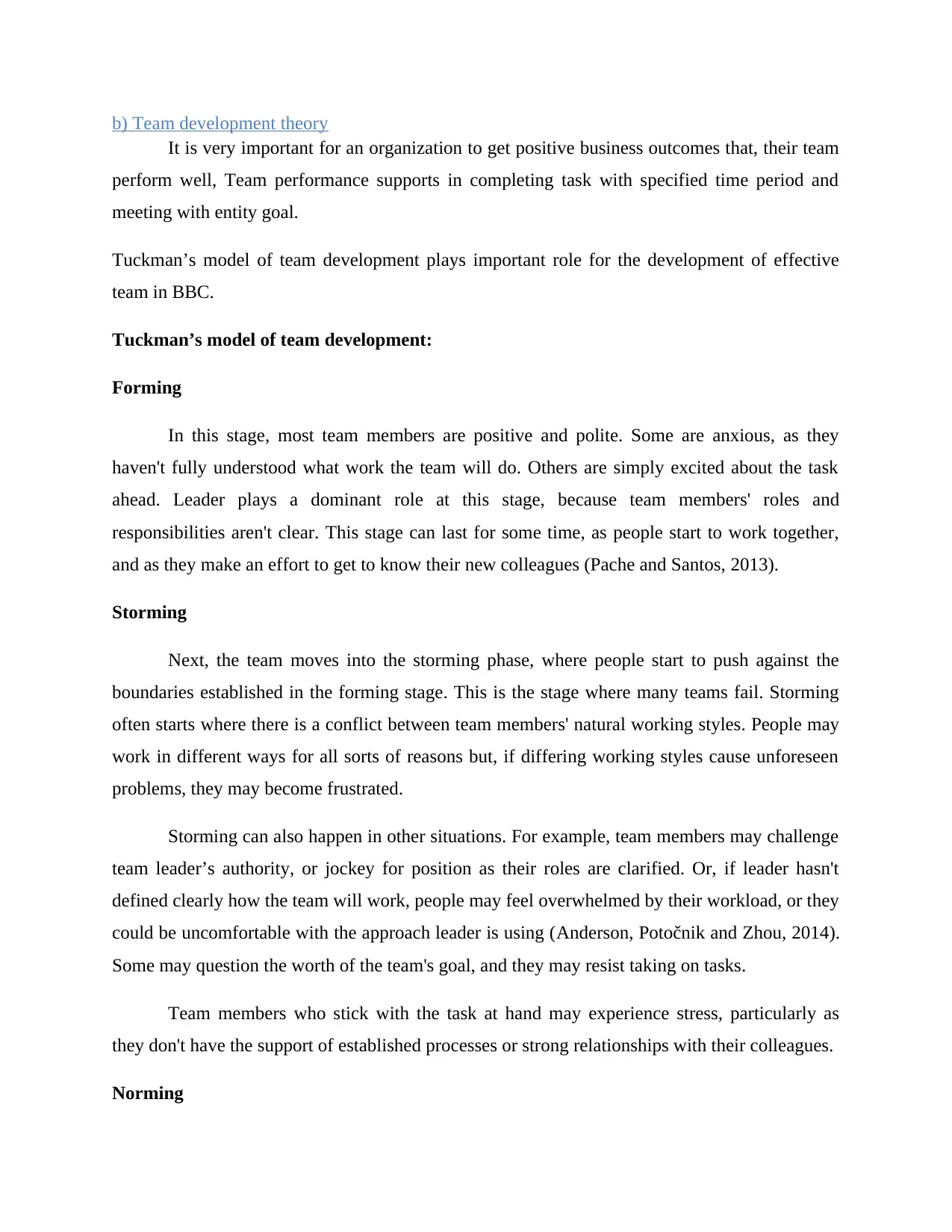
b) Team development theory
It is very important for an organization to get positive business outcomes that, their team
perform well, Team performance supports in completing task with specified time period and
meeting with entity goal.
Tuckman’s model of team development plays important role for the development of effective
team in BBC.
Tuckman’s model of team development:
Forming
In this stage, most team members are positive and polite. Some are anxious, as they
haven't fully understood what work the team will do. Others are simply excited about the task
ahead. Leader plays a dominant role at this stage, because team members' roles and
responsibilities aren't clear. This stage can last for some time, as people start to work together,
and as they make an effort to get to know their new colleagues (Pache and Santos, 2013).
Storming
Next, the team moves into the storming phase, where people start to push against the
boundaries established in the forming stage. This is the stage where many teams fail. Storming
often starts where there is a conflict between team members' natural working styles. People may
work in different ways for all sorts of reasons but, if differing working styles cause unforeseen
problems, they may become frustrated.
Storming can also happen in other situations. For example, team members may challenge
team leader’s authority, or jockey for position as their roles are clarified. Or, if leader hasn't
defined clearly how the team will work, people may feel overwhelmed by their workload, or they
could be uncomfortable with the approach leader is using (Anderson, Potočnik and Zhou, 2014).
Some may question the worth of the team's goal, and they may resist taking on tasks.
Team members who stick with the task at hand may experience stress, particularly as
they don't have the support of established processes or strong relationships with their colleagues.
Norming
It is very important for an organization to get positive business outcomes that, their team
perform well, Team performance supports in completing task with specified time period and
meeting with entity goal.
Tuckman’s model of team development plays important role for the development of effective
team in BBC.
Tuckman’s model of team development:
Forming
In this stage, most team members are positive and polite. Some are anxious, as they
haven't fully understood what work the team will do. Others are simply excited about the task
ahead. Leader plays a dominant role at this stage, because team members' roles and
responsibilities aren't clear. This stage can last for some time, as people start to work together,
and as they make an effort to get to know their new colleagues (Pache and Santos, 2013).
Storming
Next, the team moves into the storming phase, where people start to push against the
boundaries established in the forming stage. This is the stage where many teams fail. Storming
often starts where there is a conflict between team members' natural working styles. People may
work in different ways for all sorts of reasons but, if differing working styles cause unforeseen
problems, they may become frustrated.
Storming can also happen in other situations. For example, team members may challenge
team leader’s authority, or jockey for position as their roles are clarified. Or, if leader hasn't
defined clearly how the team will work, people may feel overwhelmed by their workload, or they
could be uncomfortable with the approach leader is using (Anderson, Potočnik and Zhou, 2014).
Some may question the worth of the team's goal, and they may resist taking on tasks.
Team members who stick with the task at hand may experience stress, particularly as
they don't have the support of established processes or strong relationships with their colleagues.
Norming
Paraphrase This Document
Need a fresh take? Get an instant paraphrase of this document with our AI Paraphraser
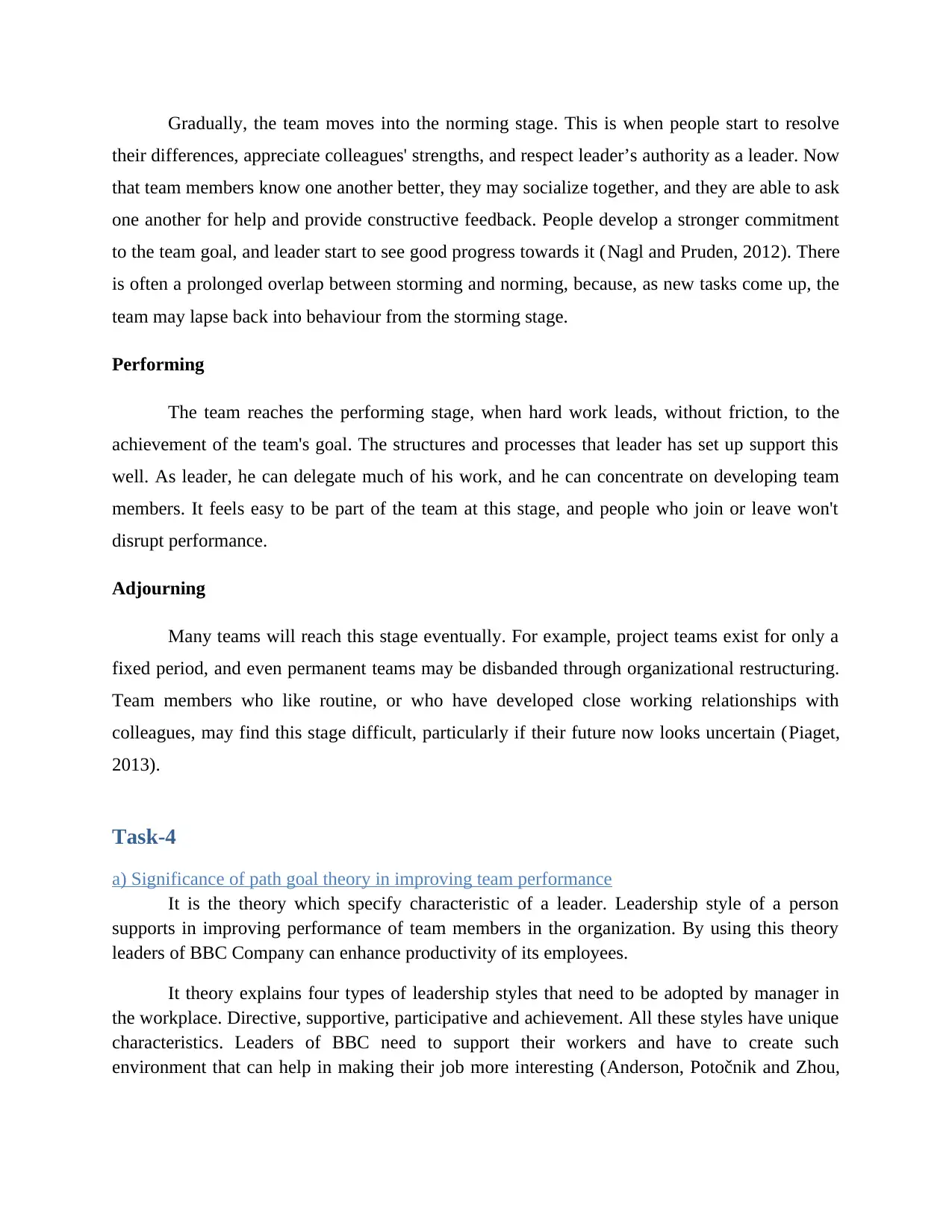
Gradually, the team moves into the norming stage. This is when people start to resolve
their differences, appreciate colleagues' strengths, and respect leader’s authority as a leader. Now
that team members know one another better, they may socialize together, and they are able to ask
one another for help and provide constructive feedback. People develop a stronger commitment
to the team goal, and leader start to see good progress towards it (Nagl and Pruden, 2012). There
is often a prolonged overlap between storming and norming, because, as new tasks come up, the
team may lapse back into behaviour from the storming stage.
Performing
The team reaches the performing stage, when hard work leads, without friction, to the
achievement of the team's goal. The structures and processes that leader has set up support this
well. As leader, he can delegate much of his work, and he can concentrate on developing team
members. It feels easy to be part of the team at this stage, and people who join or leave won't
disrupt performance.
Adjourning
Many teams will reach this stage eventually. For example, project teams exist for only a
fixed period, and even permanent teams may be disbanded through organizational restructuring.
Team members who like routine, or who have developed close working relationships with
colleagues, may find this stage difficult, particularly if their future now looks uncertain (Piaget,
2013).
Task-4
a) Significance of path goal theory in improving team performance
It is the theory which specify characteristic of a leader. Leadership style of a person
supports in improving performance of team members in the organization. By using this theory
leaders of BBC Company can enhance productivity of its employees.
It theory explains four types of leadership styles that need to be adopted by manager in
the workplace. Directive, supportive, participative and achievement. All these styles have unique
characteristics. Leaders of BBC need to support their workers and have to create such
environment that can help in making their job more interesting (Anderson, Potočnik and Zhou,
their differences, appreciate colleagues' strengths, and respect leader’s authority as a leader. Now
that team members know one another better, they may socialize together, and they are able to ask
one another for help and provide constructive feedback. People develop a stronger commitment
to the team goal, and leader start to see good progress towards it (Nagl and Pruden, 2012). There
is often a prolonged overlap between storming and norming, because, as new tasks come up, the
team may lapse back into behaviour from the storming stage.
Performing
The team reaches the performing stage, when hard work leads, without friction, to the
achievement of the team's goal. The structures and processes that leader has set up support this
well. As leader, he can delegate much of his work, and he can concentrate on developing team
members. It feels easy to be part of the team at this stage, and people who join or leave won't
disrupt performance.
Adjourning
Many teams will reach this stage eventually. For example, project teams exist for only a
fixed period, and even permanent teams may be disbanded through organizational restructuring.
Team members who like routine, or who have developed close working relationships with
colleagues, may find this stage difficult, particularly if their future now looks uncertain (Piaget,
2013).
Task-4
a) Significance of path goal theory in improving team performance
It is the theory which specify characteristic of a leader. Leadership style of a person
supports in improving performance of team members in the organization. By using this theory
leaders of BBC Company can enhance productivity of its employees.
It theory explains four types of leadership styles that need to be adopted by manager in
the workplace. Directive, supportive, participative and achievement. All these styles have unique
characteristics. Leaders of BBC need to support their workers and have to create such
environment that can help in making their job more interesting (Anderson, Potočnik and Zhou,
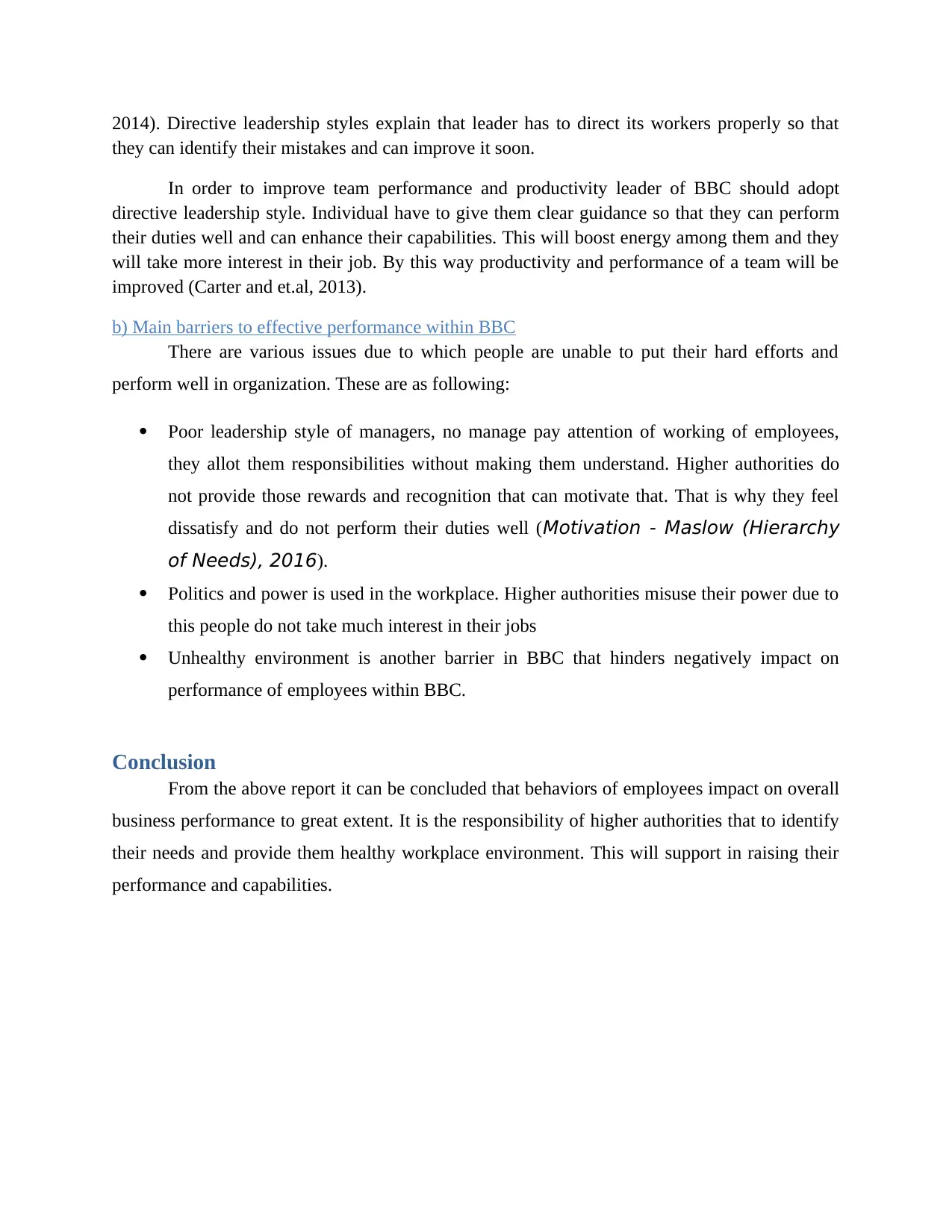
2014). Directive leadership styles explain that leader has to direct its workers properly so that
they can identify their mistakes and can improve it soon.
In order to improve team performance and productivity leader of BBC should adopt
directive leadership style. Individual have to give them clear guidance so that they can perform
their duties well and can enhance their capabilities. This will boost energy among them and they
will take more interest in their job. By this way productivity and performance of a team will be
improved (Carter and et.al, 2013).
b) Main barriers to effective performance within BBC
There are various issues due to which people are unable to put their hard efforts and
perform well in organization. These are as following:
Poor leadership style of managers, no manage pay attention of working of employees,
they allot them responsibilities without making them understand. Higher authorities do
not provide those rewards and recognition that can motivate that. That is why they feel
dissatisfy and do not perform their duties well (Motivation - Maslow (Hierarchy
of Needs), 2016).
Politics and power is used in the workplace. Higher authorities misuse their power due to
this people do not take much interest in their jobs
Unhealthy environment is another barrier in BBC that hinders negatively impact on
performance of employees within BBC.
Conclusion
From the above report it can be concluded that behaviors of employees impact on overall
business performance to great extent. It is the responsibility of higher authorities that to identify
their needs and provide them healthy workplace environment. This will support in raising their
performance and capabilities.
they can identify their mistakes and can improve it soon.
In order to improve team performance and productivity leader of BBC should adopt
directive leadership style. Individual have to give them clear guidance so that they can perform
their duties well and can enhance their capabilities. This will boost energy among them and they
will take more interest in their job. By this way productivity and performance of a team will be
improved (Carter and et.al, 2013).
b) Main barriers to effective performance within BBC
There are various issues due to which people are unable to put their hard efforts and
perform well in organization. These are as following:
Poor leadership style of managers, no manage pay attention of working of employees,
they allot them responsibilities without making them understand. Higher authorities do
not provide those rewards and recognition that can motivate that. That is why they feel
dissatisfy and do not perform their duties well (Motivation - Maslow (Hierarchy
of Needs), 2016).
Politics and power is used in the workplace. Higher authorities misuse their power due to
this people do not take much interest in their jobs
Unhealthy environment is another barrier in BBC that hinders negatively impact on
performance of employees within BBC.
Conclusion
From the above report it can be concluded that behaviors of employees impact on overall
business performance to great extent. It is the responsibility of higher authorities that to identify
their needs and provide them healthy workplace environment. This will support in raising their
performance and capabilities.
⊘ This is a preview!⊘
Do you want full access?
Subscribe today to unlock all pages.

Trusted by 1+ million students worldwide
1 out of 14
Related Documents
Your All-in-One AI-Powered Toolkit for Academic Success.
+13062052269
info@desklib.com
Available 24*7 on WhatsApp / Email
![[object Object]](/_next/static/media/star-bottom.7253800d.svg)
Unlock your academic potential
Copyright © 2020–2025 A2Z Services. All Rights Reserved. Developed and managed by ZUCOL.





